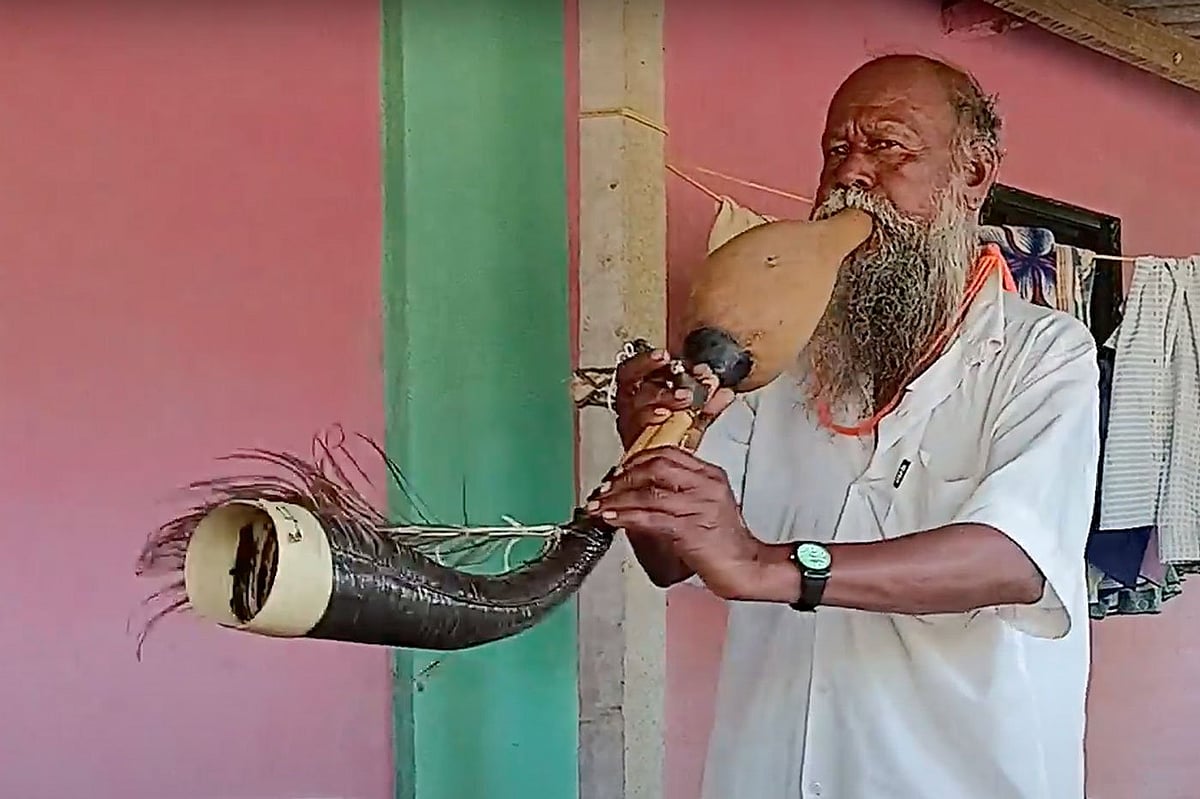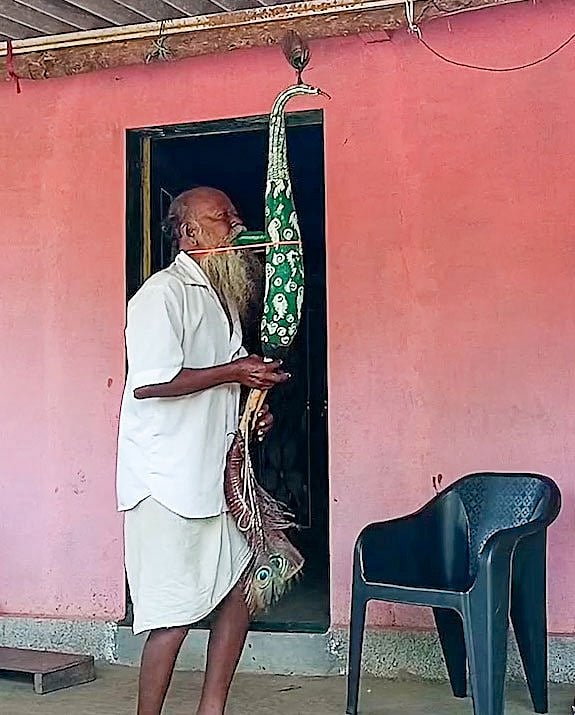Finding God in a gourd: "My tarpa is my deity"
Bhiklya Ladkya Dhinda is a Warli Adivasi. The 89-year-old plays the tarpa, a traditional wind instrument made of palm leaf, bamboo and dried bottlegourd

Our Warli (also spelt as Varli) people feel the wind inside their body when I play tarpa. For an hour, their bodies move (are possessed) just like a tree that moves with the wind. When I play, I call upon Savari Devi and her companions. And my people get possessed by the one who responds. It is all about faith.
‘Maanal tyaacha dev, naahi tyaacha naahi (A believer has a god, an atheist has none)’. For me, my tarpa is my deity. So, I join my hands and worship it. Navshya, my great grandfather, played the tarpa. His son, Dhaklya. He played it. Dhaklya’s son Ladkya. He too played it. Ladkya was my father.
It was British rule. We had not attained freedom. In our village, Walwande, there was only one school for children of ‘big’ (upper caste) people. No school for the poor. I was 10–12 years old at the time. I tended the cattle.
My parents thought ‘gayimage gela tar roti milal. Shalet gela tar upashi rahal (if I tended the cattle I would get to eat. If I went to school, I would go hungry).’ My mother had seven children to care for. My father would say, “You have nothing to do when cattle are grazing. Why don’t you play tarpa? It helps your body and health and it also entertains you.” Because of the sound no insects will come near the cattle.
I started playing it when I was in the forests and grazing grounds. People would complain, “Dhindya’s son was making noise the entire day, kyav kyav.” My father said one day, “As long as I am alive, I will make the tarpa for you. Once I am gone, who will?” So, I learnt the art.
You need three things to make a tarpa. Leaves of the maad (palm toddy) tree to make the ‘sound’ (resonant horn chamber). Two pieces of bamboo [cane], one for the female and one for male. The male has another small piece to tap and keep rhythm.
The third thing that you need is dudhi (bottle gourd) for wind chest. When I blow into the blow hole, the male and female unite and create the most attractive sound. Tarpa is just like a family. There is a male and a female. When I blow some air, they unite and the sound that you get is magical. Like a stone, it is lifeless.
But with my breath it comes alive and produces a sound, a musical note. It requires a chest full of air. One has to blow in the instrument and also make sure that your body has enough air to breathe. It is the wisdom from god that we can make such an instrument. It belongs to god. My parents and old people told us many stories.
If I share those today, people call me names. But these were told to us by our ancestors. The gods left after the creation of brahmand (universe). Where did the Warlis come from then? From Kandram Dehlya. The gods kept some curd for Kandram Dehlya with his mother. He ate the curd but also ate the buffalo.
His mother got angry and threw him out of the house. Our ancestors tell us how the first Warli, Kandram Dehlya reached here. Like Warlis, many communities have lived here. Rajkoli, Kokna, Katkari, Thakur, Mahar, Chambhar… I remember I worked at maharaja’s (king of Jawhar’s) durbar. He ate on karval leaves along with all the people who ate in his durbar. I worked there and threw away the used leaves.
All communities gathered there and ate in one row. No one was treated as being lesser than the other. I learnt it there and began having water at the hands of a Katkari or a Musalman. Rajkolis do not accept water touched by Warlis. Our people do not drink water touched by Katkari or a Chambhar or a Dhor Koli. They still do not. But I never believed in such discrimination.
See, anyone who worships Hirva Dev and tarpa is a Warli Adivasi. We celebrate the festivals together. When new rice is harvested, we share it with the family, with the neighbours and take it first to the Gaondevi, our village deity. Only after offering her the first morsel, we eat it.
You might think of this as andh shraddha (blind faith). But it is not that. It is our shraddha, our faith. With the new harvest, we visit the temple of Gaondevi, our local deity. Why did we construct a temple for her and bring her here? We pray to her, “Keep our children, relatives, cattle and labour, hale and hearty. Let our fields and orchards flourish. Those who are in jobs, let them see success. Let our families and our lives see good days.”
***

We Adivasis visit the temple and pray to our deity, take her name and say our wishes. Tarpa plays an important role in our lives. On Waghbaras, we celebrate Savari Devi’s festival. You know her as Shabari, one who gave Lord Ram the half-eaten berries. We have a different story.
Savari Devi was waiting for Ram in the forest. He came there with Sita. Savari met him and told him that she had been waiting for him forever and now that she has seen him, she has nothing else to live for. She took out her jeevda (heart) and kept it in his hands and went off, never to return.
To celebrate her love and dedication, we take the tarpa to the hills and forests. There, in the forest live many deities. Tangda Savari, Gohra Savari, Popta Savari, Tumba Savari and Ghunga Savari. All of them are Savari Devi’s friends. They are deities of nature. They exist. Even now, they do.
We started worshipping them. I play tarpa and invite them to the celebration. The way we call someone by name, I play different tunes for each Savari. The tunes change for each one of them.
It was 2022. I was on the stage with Adivasis from all over: Nandurbar, Dhule, Baroda… The people sitting there in front asked me to prove that I was an Adivasi.
I told them that the first person who landed on this earth and tested its soil was an Adivasi, and that human being was my ancestor. I said, our culture is the sound we create with our breath. What we play with our hands is what you see in the painting. The painting came later. The breath and the music are eternal. The sounds have been here since the origin of the universe.
I ended by saying that this tarpa represents a couple, the male supports the female and the female supports the male. Tarpa works just like that. A breath unites them and creates the most magical sound.
My answer got me the first spot. I got my state the first rank!
With folded hands, I used to tell my tarpa, “Dear god, I serve you, I worship you. Now, in return, you should also look after me. I want to fly. Put me on an aeroplane.” And, believe it or not, my tarpa took me on a flight. Bhiklya Ladkya Dhinda travelled in an aeroplane. I visited so many places.
I went to Alandi, Jejuri, Baramati, Sanya (Shani) Shinganapur… I travelled far and wide. No one from here has been to Panjim, the capital of Goma (Goa). But I went there. I have got a certificate from there. I have many things to share but I don’t. I am 89 years old and there are so many stories. But I never tell them. I have kept them in my heart. Many reporters and journalists come and write down my story.
They publish books and tell the world that they have made me famous. Many musicians come and try and steal my music. So, I don’t meet everyone. You are fortunate to have met me. I got the Sangeet Natak Akademi award. The function was in Delhi. When I received the award, my eyes welled up. My father never sent me to school. He thought I may or may not get a job with my education.
But he told me that “this instrument is our deity”. It is indeed a deity. It gave me everything. It taught me humanity. People know my name world over. My tarpa is printed on a postal stamp. If you press a button in my name on your phone, you will see my video. What more do you want? A frog in a well does not know what is outside that hole. But I stepped out of that well. I saw the world.
Today’s youngsters don’t dance to tarpa tunes. They get the DJ. Let them. But tell me one thing, when we get our harvest from the field, when we take the offering of new rice to the Gaondevi, when we take her name and pray to her, will we play the DJ?
In those moments it is just the tarpa, nothing else.
Interview, transcription and English translation by Medha Kale. Courtesy: People’s Archive of Rural India (PARI)
Follow us on: Facebook, Twitter, Google News, Instagram
Join our official telegram channel (@nationalherald) and stay updated with the latest headlines
Published: 03 Mar 2024, 7:35 PM

![Bhiklya baba in the dudhi (bottlegourd) patch in his courtyard. He ties each one with string and stones to give it the required shape. "‘I grow these only to make tarpa. If someone steals and eats it, he will surely get a kestod [furuncle] or painful throat," he says](https://media.assettype.com/nationalherald%2F2024-03%2Fb6afbe71-c962-417c-8b87-5e23ded6ba7f%2F04_MK_and_SS_My_tarpa_is_my_deity_max_1400x1120.jpg?auto=format%2Ccompress)


